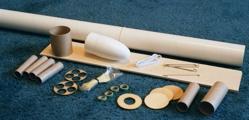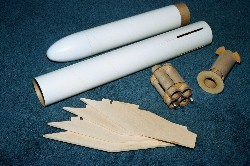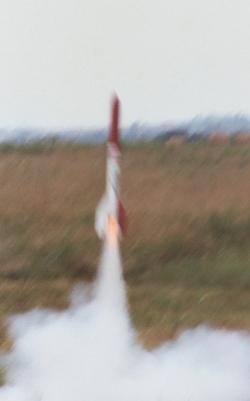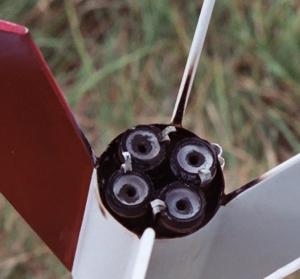Scratch Super Ranger Original Design / Scratch Built
Scratch - Super Ranger {Scratch}
Contributed by Tim Burger
| Manufacturer: | Scratch |
Brief: Scratch-built four (4) 24mm motor cluster rocket resembling the Super Big Bertha
 This project began as an extension of a pair of rockets already in my fleet. I’ve had a regular size Big Bertha for over 10 years that flies great. When working on NARTREK Silver I chose to build a Ranger - a classic Estes kit that predates the Big Bertha - to fulfill the cluster flight requirement. I thought that the two rockets would make great complimentary birds and even painted the new Ranger to match the Bertha in an inverted paint scheme. The new Ranger turned out great and they look neat together. I’ve had an Estes Super Bertha kit laying around the house for a couple of years and it dawned on me one afternoon recently that a pair of Supers would be as much fun. The parts weren’t hard to come by; the centering rings were custom cut for me by the Balsa Machining Service, the tubing all came from Totally Tubular, and the plastic cone came from the local hobby shop (it’s an Estes part.) My version also includes a baffle to avoid problems with wadding. I also decided that it might be a kick to fly on the new Estes E9 motors, so the mounts were designed to accommodate this new product.
This project began as an extension of a pair of rockets already in my fleet. I’ve had a regular size Big Bertha for over 10 years that flies great. When working on NARTREK Silver I chose to build a Ranger - a classic Estes kit that predates the Big Bertha - to fulfill the cluster flight requirement. I thought that the two rockets would make great complimentary birds and even painted the new Ranger to match the Bertha in an inverted paint scheme. The new Ranger turned out great and they look neat together. I’ve had an Estes Super Bertha kit laying around the house for a couple of years and it dawned on me one afternoon recently that a pair of Supers would be as much fun. The parts weren’t hard to come by; the centering rings were custom cut for me by the Balsa Machining Service, the tubing all came from Totally Tubular, and the plastic cone came from the local hobby shop (it’s an Estes part.) My version also includes a baffle to avoid problems with wadding. I also decided that it might be a kick to fly on the new Estes E9 motors, so the mounts were designed to accommodate this new product.
Construction:
Parts List:
- 1 Nose Cone Estes PNC-80B
- 1 Body Tube 2.6" x 18" Totally Tubular
- 1 Body Tube 2.6" x 11" Totally Tubular
- 4 Motor Tubes 24mm x 3 1/4" Totally Tubular
- 4 70 mm Motor hooks Estes bag 'o hooks
- 4 Motor blocks Estes CR2050
- 1 Baffle Tube 29mm x 4" Totally Tubular
- 1 Baffle Tube Estes BT-60 4" or 1.6" Totally Tubular
- 2 Fin Stock 1/8" x 4" x 36" Basswood Local hobby shop
- 2 Launch Lugs 1/4" x 1" Apogee Components
- 2 Motor Rings 2.6" x 1/8" ply with 4-24mm holes Balsa Machining Service
- 1 Baffle Ring 2.6" x 1/8" ply with 29mm Center hole Balsa Machining Service
- 2 Bulkheads 2.6" x 1/8" ply Balsa Machining Service
- 1 300# Kevlar (tm) cord 5' long Apogee Components or Into the Wind
- 1 3/8" Elastic cord 36" long
- 1 24" Nylon 'chute
- 1 Tube Joiner Estes BT-60 joiner or Totally Tubular part
- 1 screw eye w/nut #10 or 1/4"
- 1 1/2" welded ring
 This rocket is a little different than a common rocket because of the motor mount since the mount is really four mounts glued together into a set of rings. Test fit the motor tubes into the ring holes and sand the inside of the rings as needed to get a good snug but not overly tight fit. The holes will also require a notch for the motor hook. This notch should be located such that the flat part of the hook will be facing the spot where the motor tube next to it is closest to the airframe. This will allow the room for the hook to flex without bumping or rubbing against the neighboring tube or the airframe. The notch only needs to be about a 1/16 deep and 3/16 wide. Glue a motor block ring flush with the end of each of the motor tubes. Bend the top hook of each of the motor hooks back so that it is facing the other direction. Glue the motor tubes into one of the centering rings with the centering ring at 65mm from the end opposite the blocks with the top of the hooks trapped in the notches. The ends of the hooks should hang over the rear ends of the motor tubes about 5mm. Now, with the hooks in place, glue the other ring over the lower end of the motor tubes, about 5mm up from the end. The 95mm long E9 motors should now just fit in the mounts. A 70mm D12 will also work well in these mounts with a 25mm long spacer cut from a spent motor.
This rocket is a little different than a common rocket because of the motor mount since the mount is really four mounts glued together into a set of rings. Test fit the motor tubes into the ring holes and sand the inside of the rings as needed to get a good snug but not overly tight fit. The holes will also require a notch for the motor hook. This notch should be located such that the flat part of the hook will be facing the spot where the motor tube next to it is closest to the airframe. This will allow the room for the hook to flex without bumping or rubbing against the neighboring tube or the airframe. The notch only needs to be about a 1/16 deep and 3/16 wide. Glue a motor block ring flush with the end of each of the motor tubes. Bend the top hook of each of the motor hooks back so that it is facing the other direction. Glue the motor tubes into one of the centering rings with the centering ring at 65mm from the end opposite the blocks with the top of the hooks trapped in the notches. The ends of the hooks should hang over the rear ends of the motor tubes about 5mm. Now, with the hooks in place, glue the other ring over the lower end of the motor tubes, about 5mm up from the end. The 95mm long E9 motors should now just fit in the mounts. A 70mm D12 will also work well in these mounts with a 25mm long spacer cut from a spent motor.
Now for the baffle. Start by gluing the 29mm tube flush with the end of the 29mm to 2.6 inch centering ring. Now glue the piece of BT-60 to one of the disks; carefully center the tube on the disk. Add some strips of balsa to the 29mm tube that are cut from scrap. The strips should run the length of the 29 mm tube and are to center the BT-60 around it. When the glue on these parts is dry, glue the BT-60 to the strips on the 29mm tube. There should be about an inch gap between the ends of the tube and the rings. Now cut away three equally sized and equally spaced tabs from the outside edge of the disk glued to the BT-60.
 Let me put in a word about how the baffle works. The ejection charge will be forced up into the 29mm tube and will run into the disk above. The charge will then be forced down into the space between the 29mm tube and the BT-60. It will run into the lower ring and be forced up between the BT-60 and the inside airframe tube wall. It with then pass out through the tabs cut out of the top disk into the recovery compartment forcing the 'chute/cord out the top of the tube. It works by trapping the hot clay, burning powder, and hot gases and allowing them to cool or burn out thus protecting the recovery system.
Let me put in a word about how the baffle works. The ejection charge will be forced up into the 29mm tube and will run into the disk above. The charge will then be forced down into the space between the 29mm tube and the BT-60. It will run into the lower ring and be forced up between the BT-60 and the inside airframe tube wall. It with then pass out through the tabs cut out of the top disk into the recovery compartment forcing the 'chute/cord out the top of the tube. It works by trapping the hot clay, burning powder, and hot gases and allowing them to cool or burn out thus protecting the recovery system.
Tie one end of the Kevlar string to the top of the BT-60 and glue it to the joint where the BT-60 meets the disk. Tie a loop in the Kevlar an inch or two above the ring and tie one end of the elastic strap to this loop. Lightly wrap the Kevlar and elastic and tape it to the top of the disk to keep it out of the way when the baffle is being glued to the inside of the airframe.
Fins are made by cutting the two pieces of basswood in two. Then tack glue the four resulting pieces of wood together. I used one of the fins from the Super Big Bertha as a pattern, and added a tab at the root edge for through the wall mounting. Now cut out the fins using a band or jig saw. Use a disk sander to sand the fins to a nice square uniform shape. Pop the pieces apart and use the disk sander to rough in a rounded leading and trailing edge on each of the fins. Use a sanding block to finish shaping.
Epoxy the baffle assembly into the airframe tube with the cut disk towards the front of the rocket and the 29mm tube towards that back. The aft ring should be located 4 3/4" in from the aft end of the airframe. This should allow about an inch of space in front of the motor tubes when they are glued in. Coat the lower inside of the 29mm tube, the aft ring, and about an inch of the inside of the airframe next to the baffle with epoxy to protect them from the ejection charges. When the epoxy is cured, pull the taped shock cord loose from the top of the disk, and using a long stick place a fillet of epoxy on the tabs where they meet the airframe.
Now mark the airframe tube with four lines running parallel with the length of the tube and equally spaced around it. Draw another four lines the width of your fins away from the first set. Now draw a line around the airframe at 65mm and another at 5mm. Now cut four slots the width of the fins along the long lines between the two rings. Test fit the motor assembly in the body tube and test fit the fins in the slots — each fin tab should reach through the airframe and center up between two of the motor tubes, rotate the motor assembly as needed. When satisfied with the fit, remove the fins and epoxy the motor assembly into the airframe. Use the epoxy sparingly — it would be very easy to overdo the use of epoxy and add too much unnecessary weight to the aft end of the rocket. Install a pair of fins in the slots (with out gluing) to hold the motor assembly in the proper orientation while the epoxy cures. Epoxy in the fins - I did this in pairs, using a metal straight edge across the flat of the two fins to ensure that they are square.
Add fin fillets to the root edge of the fins and glue on a set of launching lugs.
Drill a hole just bigger than the screw eye in the remaining disk. Fit the screw eye through the hole, and thread the nut on. Use pliers or a wrench to tighten the nut and use epoxy or thread lock on the threads to keep it from coming loose over time. Now carefully glue the ring to the joiner tube making sure that it’s well centered on the end of the joiner with the screw eye facing out. Now glue the joiner into one end of the 11" tube. The nose cone goes in the other end of this tube (in case you hadn’t guessed.) Make sure it fits very snuggly to avoid it getting lost.
Now tie the welded ring to the elastic cord at about the halfway point. Tie the free end of the elastic to the screw eye. Pass the free end of the Kevlar cord through the ring and tie it to the screw eye. Place a dot of glue on the knots to keep them from unraveling. The ’chute is attached to the ring. The elastic gives and stretches at ejection, the Kevlar backs it up preventing separations.
Your rocket should be ready to fly at this point. You could splash some paint on it too.
Finish:
The spiral and body tube joint was filled with Elmer’s Fill ’n’ Finish. I will normally thin the filler with a little water right in the tub and stir it until it’s about the consistency of pancake batter. Then apply it into the grooves either with the end of a toothpick or a painter’s knife. Allow the filler to dry and then sand with 200 grit paper. Add a second layer, if needed, and then sand the whole rocket lightly with 400 grit paper. Mask off the motor hooks with masking tape.
Carefully clean the rocket of any dust and wipe with a paper towel that has been lightly dampened with mineral spirits to remove any finger prints, grease, dirt, etc. Spray on a coat of white primer and let it dry. Look for any gaps or voids in the fillets, spirals, and at the tube joint. I’ll normally work on these areas more if I find any imperfections. Then sand the whole thing with 400 grit paper until the primer is so thin that the parts beneath begin to show through. Wipe it clean again and apply a second, thin layer of primer and sand it smooth with 400 or 600 grit paper. The rocket should be baby-bottom smooth at this point.
Wipe it clean again and spray on the white base coat; two or three thin coats spaced an hour or so apart should do it. I always get carried away and put on too much paint at once which causes runs; try to resist this temptation. The paint needs to dry at least two days before masking and applying the second coat.
On my rocket, I wanted one white fin, with the rest the red, and a set of red bands separating the white and red areas. The masks were cut using standard masking tape, a sharp knife, and a metal rule. A thin pencil line was drawn where the masks would go using a piece of paper wrapped around the tube. The masking tape was applied to a clean piece of glass and removed a couple of times to reduce the tackiness and prevent it from damaging the paint below. It’s important to burnish around the edges of the tape to keep the paint from running under the edges. I forgot to do this, and it resulted in rough edges. I usually let the paint dry about an hour or so before pulling the masks off to prevent the highlight peeling away with the mask. The result I arrived at was OK, the paint is nice and smooth, but my masking skills leave a bit to be desired. Always room for improvement, right?
Finally, I found a typeface on MS Word that looked a little like the font that was used on the Super Bertha and printed “Super Ranger” on a laser printer using a huge (148 point) size. I trimmed off the excess paper and taped the letters over a sheet of Monocoat Trimcoat and cut out the letters using a sharp X-acto knife. These were transferred onto the rocket body and pressed down. A pencil line was made on the airframe to aid in getting the letters on straight. It came out OK. The overall effect is great, but my poor masking skills show if you get too close.
 Flying:
Flying:
The first flight was on April 6, 2002 (finally, I’ve been waiting for an opportunity since last November!) The location was the St. Louis Rocketry Association’s April launch at the Elsberry site. This is a huge field. The temperatures were cool, and the wind was about 15MPH. It passed the check table with some concern about weather vaning due to the large fins. It was loaded on the farthest pad and the cluster of two D12-5s was connected. After some suspense waiting for clear air it was launched. The altitude was OK, and it did weather vane a little, but nothing to be concerned about. The landing was a bit harder than I wanted and a stick or something had poked a hole clean through the body tube between two of the fins just ahead of the motor mounts. Rats! I wanted to stuff more motors in it and launch it again.
I finally had an opportunity to launch it with four E9-8 motors on August 10th, 2002. The club sponsored a high power launch, complete with waivers, over a very large field. The wind was light, so I went for it. It was a beautiful flight with a very fast ignition and boost. The rocket went arrow straight to a very respectable altitude (staying well in sight), and unloaded the laundry just past apogee. The ’chute opened and it drifted about 100 yards. I took a photo of the mount afterwards - you can clearly see the heavily charred motors and mounts. In hind site, it might have been very wise to coat the inside of the rocket and all around the mounts with epoxy or some other fire inhibiting substance! As it is, the inside areas of the mounts below the centering ring were completely burned away and the areas all around the mounts were badly charred. This was all cleaned away as well as possible and the area coated with epoxy. It will fly again!
 Specs:
Specs:
- 36 inches overall length
- 11 inch payload section
- 14oz without motors
- Cp 34 inches from the nose tip (just at the point where the fin leading edges meet the body.)
- Cg in front of a spot 31 1/2 inches from the nose tip
 |
 |